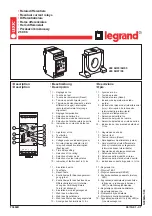
VAMP Ltd
Feeder and motor manager
Technical description
VAMP 257
VM257.EN002
VAMP 24h support phone : +358 (0)20 753 3264
7
2.
Functions
The individual protection functions of the manager can
independently be enabled or disabled according to the
requirements of the intended application. For more
information, please see the configuration instructions in
chapter 5 and 7 in the Operation and configuration part of this
manual.
2.1.
Principles of numerical protection
techniques
The manager is fully designed using numerical technology.
This means that all the signal filtering, protection and control
functions are implemented through digital processing.
The numerical technique used in the manager is primarily
based on an adapted Fast Fourier Transformation (FFT). In
FFT the number of calculations (multiplications and additions),
which are required to filter out the measuring quantities,
remains reasonable.
By using synchronized sampling of the measured signal
(voltage or current) and a sample rate according to the 2
n
series, the FFT technique leads to a solution, which can be
realized with just a 16 bit micro controller, without using a
separate DSP (Digital Signal Processor).
The synchronized sampling means an even number of 2
n
samples per period (e.g. 32 samples per a period). This means
that the frequency must be measured and the number of the
samples per period must be controlled accordingly so that the
number of the samples per period remains constant if the
frequency changes. Therefore, some current has to be injected
to the current input IL1 to adapt the network frequency for the
manager. However, if this is not possible then the frequency
must be parameterised to the manager.
Apart from the FFT calculations, some protection functions also
require the symmetrical components to be calculated for
obtaining the positive, negative and zero phase sequence
components of the measured quantity. For example, the
function of the unbalanced load protection stage is based on the
use of the negative phase sequence component of the current.













































